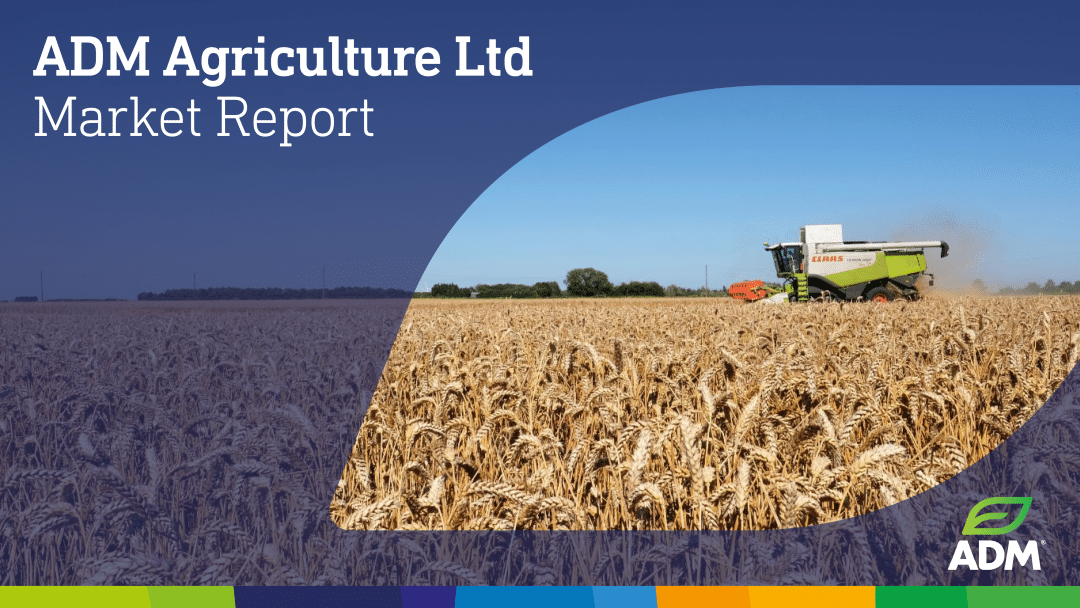WELCOME TO THE ADM AGRICULTURE WEEKLY MARKET REPORT
Wheat
- Chicago prices have firmed $3.12 per tonne week on week, but up $11.21 per tonne higher from the weekly low, as continued South American weather concerns provides support.
- Dryness concerns in Argentina, relating to corn and beans plantings continues to provide spillover support to the wheat complex. Last week Argentine crop estimates were lowered, as rating continue to decline, and with little rest-bite seen to the current dry conditions, further cuts are likely. Heavy rains in Brazil are seen causing delays to the bean harvest, and corn planting, which is also deemed as supportive to the markets.
- Reports that the recent cold snap that hit the US plains had likely caused damage to the US winter wheat crop, has also provided support, and with funds being on the short side of the market, this has triggered some short covering.
- EU prices have also firmed, up €2.50 per tonne week on week. Although following stories from across the pond, markets have been some-what subdued, with exports seen at 12.18mln t as of Jan 26th, down 37% year on year. However, as we start to see the decline in both Russian and Ukrainian export activity, reports that the general lack of snow cover increases winter-kill risks to Russian wheat production, and that Ukrainian farmers are set to sow a similar area to winter crops, this would still support the longer-term outlook, as end-season stocks for both counties are projected to be substantially lower year on year.
- UK prices have fallen week on week, down 50p/tonne, as the recovery in the UK£ limits the upside. Although down on the week, the £4-5/t rise over the past few days has caught the attention of UK growers, prompting higher levels of farm selling, which has starting to weigh on old crop premiums, especially in the more ‘over-inflated’ areas of the country.
Malting Barley
- Old crop markets are not currently trading, and unsold old crop spring barley stocks may need to go into the feed market due to continued lack of malting barley demand.
- The market focus is now on new crop and the progress of the spring planting campaign. Early drilling regions are underway, but the bulk of planting will not occur for some weeks yet.
- Anecdotally, there is some talk of poor wheat crops being replanted with spring barley, which would support the malting barley balance sheet.
- All in all, spring barley is becoming a more attractive option for 2025 with premiums nominally exceeding £40 per tonne.
Feed Barley
- Feed barley markets are steady to slightly firmer due to recent export activity and a strong rebound in wheat futures this week. Despite seeing some trade recently, export demand remains challenging, especially with the strengthening of sterling which reduces our competitiveness.
- Feed barley continues to trade at attractive levels in domestic feed markets, remaining at a healthy discount to feed wheat and corn, which once again supports inclusion rates.
- New crop activity is slow, with limited liquidity from both buyers and sellers. As a result, barley markets are tracking wheat one-for-one with on other pricing benchmark available.
- Feed barley prices for the new season are more defensively priced compared to other products, which is likely to limit demand. We expect that when farmer selling picks up, barley will have to push to find demand in both domestic and export markets.
We have range of contracts available, please get in touch with your ADM Agriculture Farm Trader for more details.
Rapeseed
- This week has given us some mixed price action in agricultural markets, starting with surprise news on Friday from the Argentine Government when they announced that they will cut their agricultural export taxes. This will fall during Argentina’s harvest, which could increase farmer selling and bring more tonnage to the global market. This coupled with a significant drop in interest rates in Argentina is likely to give the farmer less incentive to store beans as an inflation hedge as they have been in previous years.
- We have seen Dr Cordonnier lower his crop estimate 2mmt to 49mmt though this wasn’t unexpected. From here, the weather forecast has started to feature some favourable rains which will help crop conditions, but won’t be able to reverse the damage that has been done. In Brazil, favourable dryness is helping harvest progress attempt to catch up with previous years.
- Energy markets have continued on their downward trajectory this week. President Trump has urged Saudi Arabia and OPEC to bring down oil prices. Previous to this, OPEC+ has a plan to relax production quotas next quarter, the same plan that has been delayed from the third quarter of 2024. China’s official manufacturing PMI for January came in at 49.1, down from 50.1 last month. This adds to concern over the health of the Chinese economy and their crude demand.
- Canola prices have come lower this week, following positivity last week bringing board crush margins back to lower values, suppressing consumer demand. The most recent tariff talk showed that Trump still plans to introduce a 25% tariff on Canadian goods, though this may be done in two tiers, initially 10-15% on Feb 1st before imposing the full 25% in Spring.
- MATIF rapeseed prices have also come lower this week. We have seen MATIF/Canola spread close at the lowest we have seen since November. This is one to keep an eye on as an announcement from the US confirming tariffs on Canadian goods would mean that there would be canola needing to find a home which would likely need to flow into Europe. Last week we did see a small reduction in the Ukrainian crop for the coming harvest, though this is being offset but the large figures we are seeing out of Romania. From here, the inverse into new crop sits around the level that we would usually see it expire (10 year average) so the key will be how much interest remains for old crop before consumers become focused on this year’s harvest.
Oats
- European oat markets are trying to generate some activity with Scandinavian farmers reporting to be more interested in selling, however demand for Q1 is non-existent and bids for Q2 are hard to come by.
- Questions over a threatened 25% import tariff on Canadian oats into the US could see opportunities for European oats to trade across the Atlantic. However it is uncertain as to whether tariffs will also be imposed on EU goods as well. We should know more post the 1st Feb deadline, but this could get extended.
- A market for feed oats has been present this week but neither buyer or seller are prepared to budge in order to trade and this is stifling trade.
- Here in the UK markets remain generally quiet with all millers now covered for Q1 and virtually covered for Q2. This leaves July open but as we know farmers are loathed to sell this position given they want tonnages moved ahead of harvest.
Bottom line, markets remain flat to weaker with heavy UK stocks weighing on UK prices.
Pulses
- In line with the Oats, Beans have seen a much better production than expected for 24/25, with better yields supporting a crop of c. 500-550kmt
- The export pace for beans has however been slow so far, with feed beans not calculating in to the near EU markets. This was in part due to lower bean demand, but also due to a higher proportion of feed beans being available from the Baltic
- UK Quality has been better than expected this season, with a good pace of beans passing for processing and also for export, with HC vessels in the lineup to Egypt
- Prices in the UK have been relatively static post-harvest, although feed beans potentially need to push lower to buy some demand, currently being c. 15GBP/MT too expensive vs RSM, etc – New Crop Beans are nearer 25GBP/MT uncompetitive
- Expect New Crop premiums to come lower in the next couple of months as spring drilling ramps up with an expectation of good tonnages
- Old crop beans are still coming forward at a comparatively decent pace. I don’t see any major upside potential at this current time
- New crop demand peas continues to grow with consumers looking to take early coverage where they can. New crop pea buybacks are still a very attractive option for those looking to plant spring crops. For our latest buybacks please speak to your ADM Agriculture Farm Trader.
Finally, a reminder for those eligible for PGRO membership, if you’re not already on the PGRO mailing list, sign up here, where levy payers can access a wealth of free advice and support, drawing from PGRO’s extensive knowledge on pulses.
Seed
- Another busy week on the seed front, as we have seen further demand on all crops with certain products starting to become short in supply.
- Large blue peas, Butterfly and Daytona are creating interest with the exciting new contracts being offered for human consumption buybacks.
- Spring barleys are starting to tighten up on certain varieties namely Laureate & RGT Planet following the release of new malting buybacks which are catching the eye of most.
- We still have small amounts of spring wheats KWS Ladum & KWS Alicium , so if you are looking for spring wheat, please don’t leave it too late for these top choice varieties.
- Both oats and beans are getting tighter as each day passes, but we still have limited amounts to offer at this time.
- Our portfolio of maize varieties from the ultra earlies to the later maturing types are readily available at very competitive prices.
- We have a very extensive range of small seeds & SFI compliant mixes to offer.
- As always if you have any seed requirements for any products, please contact your local ADM Agriculture Farm Trader who will be delighted to hear from you and discuss any requirements and options you may have.
Fertiliser
Natural Gas
- European natural gas futures have edged toward €50 per megawatt-hour, approaching their highest level since October 2023, as colder weather drives up demand while Norwegian supply outages create further constraints.
- Outages at Norway’s Gullfaks, Troll, and Aasgard fields have tightened supply to the continent, with Norwegian gas nominations falling to 313 million cubic meters on Wednesday, a 5 mcm drop from the previous day. Meanwhile, European gas storage levels continue to deplete at an accelerated rate, currently sitting at 55.46% full, compared to 71.79% at the same time last year.
- While forecasts predict lower wind speeds, temperatures are expected to return to seasonal norms, with light to moderate frost at night. The market remains sensitive to supply risks, particularly as storage withdrawals increase amid continued demand for heating.
Ammonia
- Ammonia prices are likely to face further downward pressure moving into February, as the supply outlook remains strong while demand remains weak across most regions.
- In Northwest Europe, bullish sentiment in downstream urea and nitrate markets has provided some support, preventing sharper price corrections. However, the broader market remains under pressure, with a generally healthy supply picture keeping expectations bearish. Without a significant shift in demand fundamentals, further softening in ammonia pricing is likely in the weeks ahead.
Ammonium Nitrate (AN)
- The ammonium nitrate market remains well supported, even as ammonia prices weaken, with higher raw material costs and increasing demand across Europe continuing to provide upward pressure. The impact of four separate ammonia plant shutdowns in the past month highlights the ongoing production challenges in the region.
- In Europe, Yara released new AN 33.5% offers reflected a €30/t increase from the last official price in early December. February volumes are already reported to be sold out, further reinforcing expectations of tightening supply.
- In the UK, CF released new terms that did not reflect the level of increases anticipated by importers, which could lead to reduced willingness to import in the immediate term. This hesitation is likely to further restrict supply heading into the later stages of the spring season, as importers weigh exposure to rising global pricing against domestic retail levels that remain below replacement costs.
Urea
- The urea market remains firm, with India attempting to secure up to 1.5 Mt in its 23 January tender. The lowest offer (L1) for the west coast was submitted at $422/t CFR, while the east coast L1 came in slightly higher at $427/t CFR. Despite these price points, India’s total secured volume currently stands at 500,000 t, falling well short of its targeted 1.5 Mt, indicating continued demand pressure in the global market.
- Elsewhere, Europe, Turkey, and the US still have significant shortfalls to fill, while Ethiopia remains in the market seeking additional tonnes, further tightening global availability.
- Egyptian producers have continued to push prices higher, with vessels departing from Mopco and Abu Qir at $433/t FOB, reflecting a $2 increase from earlier this week. However, the NOLA market saw a slight correction, slipping back $7 from the week’s opening, as traders paused to reassess positioning amid rising global price momentum.
- In the UK, urea prices continue to track the global bullish trend, though the rate of increase remains less aggressive than international benchmarks. However, with global demand remaining firm and import replacement costs rising, further price increases in the domestic market remain likely in the coming weeks.
Potash:
- Potash prices remain on an upward trajectory, with further price gains expected in the coming weeks. Market sentiment is increasingly bullish, particularly in the US, where concerns over potential tariffs under President Trump’s upcoming 1 February announcement are adding upward pressure to pricing.
- Reflecting this sentiment, the world’s largest MOP producer raised US prices by $25/st on 29 January, effective immediately. This move underscores the tightening supply conditions and could set the tone for further global price adjustments.
- With demand from the spring application season approaching, and market uncertainty surrounding potential trade restrictions, potash prices are expected to remain firm, with the potential for further price gains depending on tariff decisions and supply-side developments.
Phosphates:
- Phosphate markets remain stable, with limited upside and downside risk as tight supply continues to offset affordability concerns. Prices remain high relative to downstream agricultural commodities and other fertiliser nutrients, keeping demand relatively subdued.
- Expectations suggest that prices will hold steady in the coming weeks, with potential declines in Q2 as availability improves and supply constraints ease. However, in the immediate term, the market remains well-supported.
| £/€ | £/$ | €/$ |
|---|---|---|
| 1.1955 | 1.2435 | 1.0400 |
| Feed Barley £ | Wheat £ | Beans £ | Oilseed Rape £ | |
|---|---|---|---|---|
| Feb 2025 | 155 – 170 | 182 – 197 | 205 – 220 | 420 – 425 |
NB: Prices quoted are indicative only at the time of going to press and subject to location and quality.
Although ADM Agriculture takes steps to ensure the validity of all information contained within the ADM Agriculture Market Report, it makes no warranty as to the accuracy or completeness of such information. ADM Agriculture will have no liability or responsibility for the information or any action or failure to act based upon such information. ADM Agriculture cannot accept liability arising from errors or omissions in this publication. ADM Agriculture trade under AIC contracts which incorporate the arbitration clause. Terms and Conditions of Purchase.
On every occasion, without exception, grain and pulses will be bought by incorporating by reference the terms & conditions of the AIC No.1 Grain and Peas or Beans contract applicable on the date of the transaction. Also, we will always, and without exception, buy oilseed rape and linseed by incorporating by reference the terms & conditions of the respective terms of the FOSFA 26A and the FOSFA 9A contracts applicable on the date of the transaction. It is a condition of all such transactions that the seller is deemed to know, accept and understand the terms and conditions of each of the above contracts.



